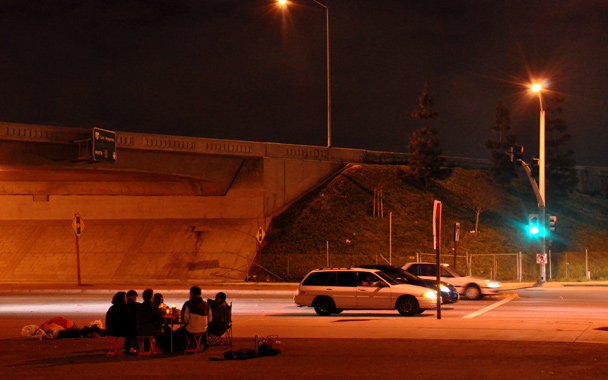You having a tea party?” shouts a woman from the rolled-down window of her SUV.
“Yes!” screams one of my dining companions, who has walked 32 miles to eat supper on this traffic island.
Cars whoosh past on the I-5 freeway overhead, a neon sign glows in the distance, and the first bite of ceviche hits me with a wallop. The grapefruit was plucked from a tree in Anaheim, the orange juice stolen from Pomona. The lemon thyme came from a kindly gardener at the start of our trip 36 hours ago. It is the best ceviche I have ever tasted.
If ink in the media world could leave a visible trace, Michael Hebb (formerly Hebberoy) would be black and blue all over. The 33-year-old started “creating tables” 13 years ago, joining partner Naomi Pomeroy (they fused their names when they married in 2004) to launch Family Supper, an illegal restaurant, in 2001. The duo expanded to start “real” Portland restaurants—Clarklewis, Ripe, and Gotham Building Tavern—garnering critical praise. Then, early in 2006, the bottom fell out of the dream: Some say that Hebb was dishonest about the financial health of his company (a charge he denies, saying that “we were just reading the books wrong”); a stormy divorce, restaurant closures, and a cloud of negative media attention followed.
But now the restaurateur has started over in Seattle with a new partner and a new obsession: cooking and eating dinner in weird places. After hosting a candlelit supper in a Seattle airport hangar and chatting about pornography with Gore Vidal in Hollywood, Hebb is now fixated on the I-5 freeway, which winds 1378 miles from Washington State through California. It is a civic space that millions inhabit collectively every day, solitary in their cars, so he wants “to imbue [the] landscape with meaning that has become utterly bereft of it.” Partnering with art curator Stephanie Snyder, he plans to stage a dozen dinners along the freeway over the next two years. I wrangled an invite for the first, excited to take part in a sort of gonzo-locavore expedition—we would forage for dinner ingredients on private property and in 7-11s alike along the way—and in perhaps the ultimate exploration of a city’s edible bounty. (Full disclosure: Michael is a distant acquaintance from Reed College, which we attended simultaneously for a few months, abating his leeriness about letting a reporter join his trek.)
Why walk? “Because no one walks in L.A.,” he says, plucking rosemary from the community garden of Pomona College, our starting point and the site of an exhibit based on our journey. Two safety-orange stools are folded and strapped to his back, along with two military blankets rolled cigarette-thin. Ashwin Balakrishnan, the quiet student-photographer, sports an identical getup, while I don a bright orange plastic tabletop. Matt Wiggins, a tall, cheery fellow who is a friend of Michael’s from the Portland days, is charged with shooting video of the journey. He hauls a heavy orange pack holding our gear, which he periodically trades with Michael.
We tread through suburban Claremont, which is wreathed with mist, and after a mile, I hear an elated cry. “I see lemons!”
The man who comes to the door of his modest home is wide-eyed. Michael explains his project with a smile.
“Cooking a meal?” asks the man, scratching his head. “All right, it’s weird. Awful weird.” He watches Michael scrabble in his trees. Lemons tumble into the pack.
Nearby, a tree gleams with oranges. When no one responds to a knock, Michael and Matt start batting down the fruit. A sprightly white-haired woman trots by, and asks if we got permission. Michael charms her in a flash. We’re working on an art project, he says, an excursion, and DeeDee—though she keeps her pace—lets us tail her to a neighbor’s door. “Hon, take these people to your garden.”
Lucky for us, gardeners have a proud streak, and DeeDee’s friend Kathleen, a sixty-something woman with kind eyes, struts among her pineapple sage, snap peas, nasturtiums, and lemon thyme. It is a windfall.
By now the mist has become a light rain. We take shelter at mile six, a McDonald’s. I am ravenous, and order three cheeseburgers. Michael concocts his preferred “pain cocktail”—one Ibuprofen, one Pamprin, and a slug of corn whiskey. I accept an Ibuprofen, as my feet are starting to smart, and because we are fortifying ourselves for a steep walk through Chino Hills.
We are walking along Carbon Canyon Road, where wildfires have recently blazed through. The sun is setting, fast. Outside a liquor store at mile 13, the shopkeeper drags on his cigarette, eyeing the ravine. “Pay attention when you walking. People run you over, man.” I wonder again where we will sleep. Michael had said something about a chapel just off the road. I decide not to ask—not yet.
It is desolate out here in the dark, and cold—L.A. drops to about 45 degrees at night in January—and I feel frightened for the first time. I am also hungry, and my feet are killing me. When I see another hill between my dinner and me I yell at Michael, who had promised “it’s all downhill from here” several miles ago.
“Dinner requires a hill,” he replied coolly. I inwardly curse him (and the man at the sporting-goods store who sized my feet and persuaded me I was an 8, not an 8 1/2). But a restaurant twinkles on the horizon—Sol de Mexico, an oasis of salsa and tequila—and pulls us up the hill.



 Pinterest
Pinterest


